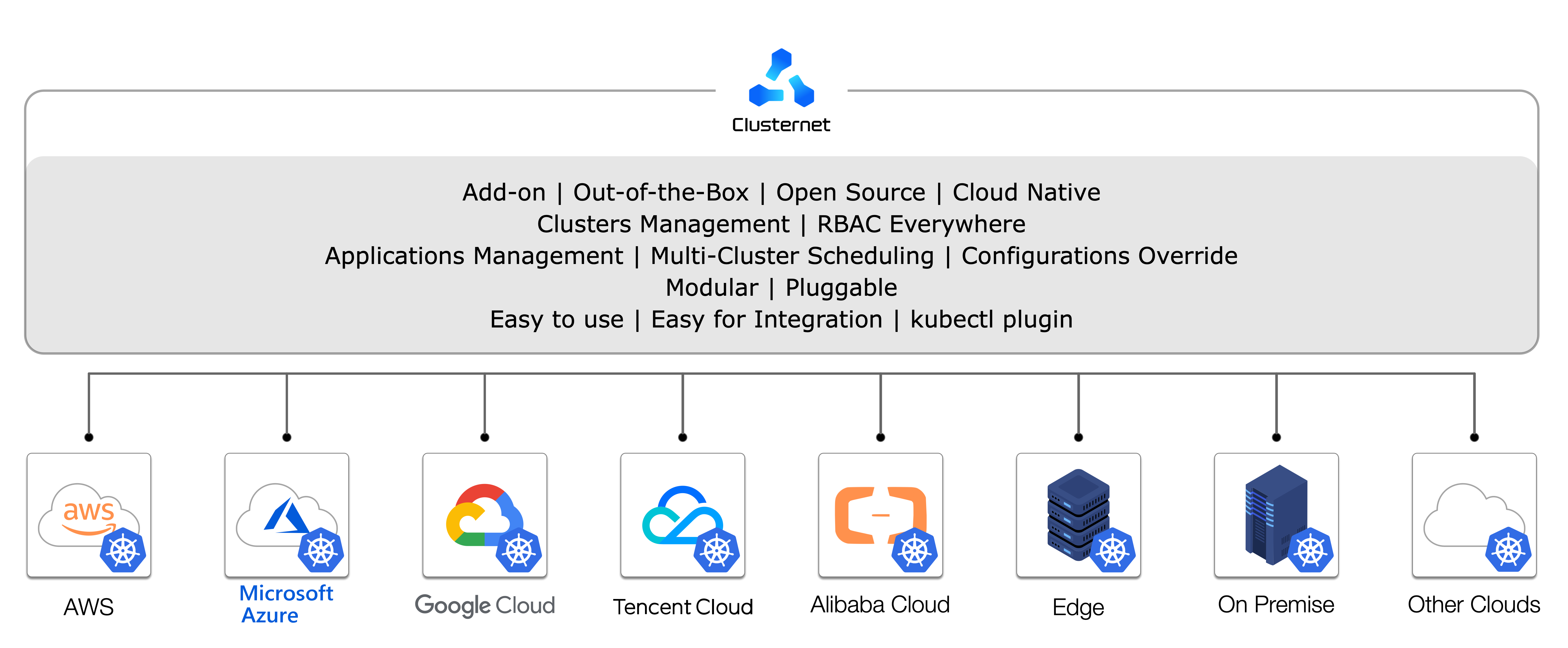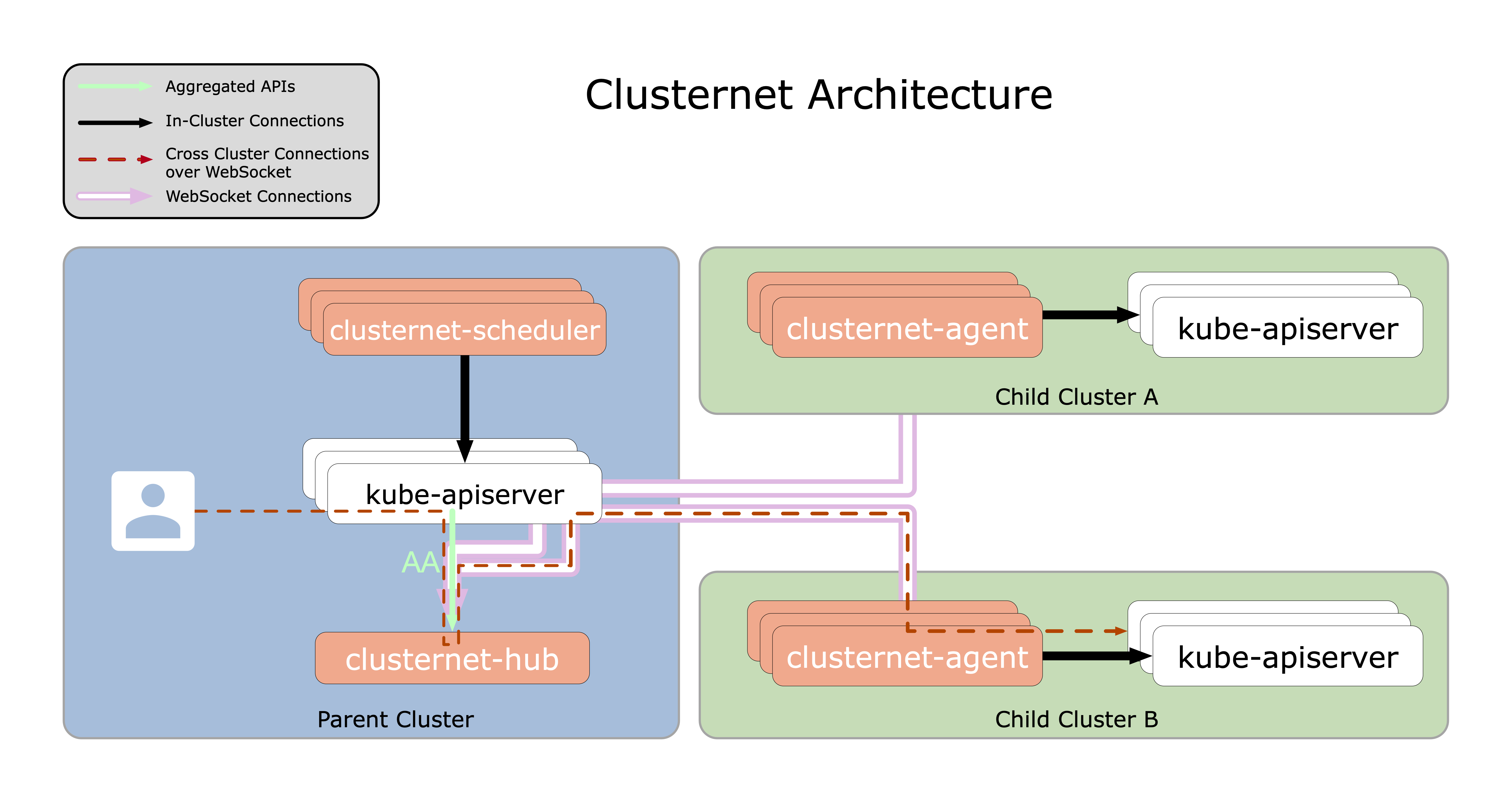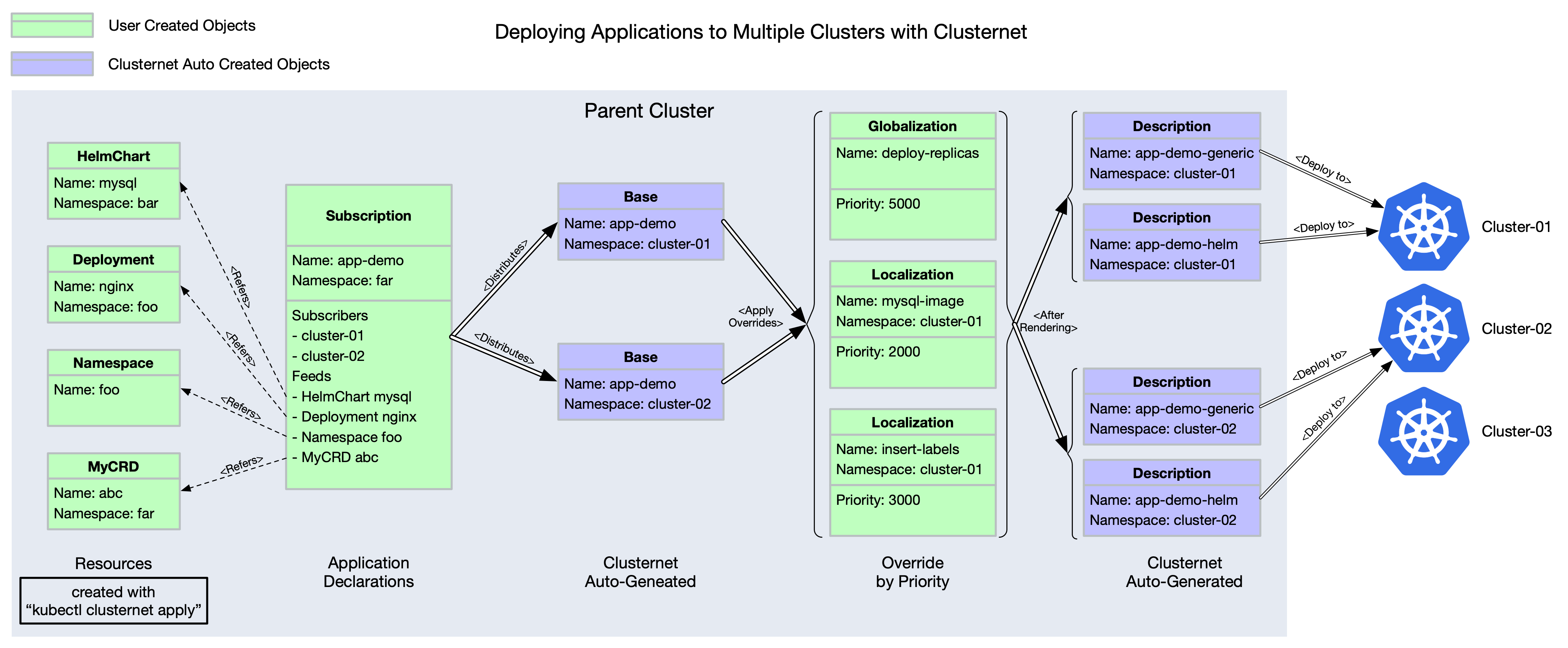Managing Your Clusters (including public, private, hybrid, edge, etc) as easily as Visiting the Internet.
Out of the Box.
Clusternet (Cluster Internet) is an open source add-on that helps you manage thousands of millions of Kubernetes clusters as easily as visiting the Internet. No matter the clusters are running on public cloud, private cloud, hybrid cloud, or at the edge, Clusternet helps setup network tunnels in a configurable way and lets you manage/visit them all as if they were running locally. This also help eliminate the need to juggle different management tools for each cluster.
Clusternet can also help deploy and coordinate applications to multiple clusters from a single set of APIs in a hosting cluster.
Clusternet also provides a Kubernetes-styled API, where you can continue using the Kubernetes way, such as KubeConfig, to visit a certain Managed Kubernetes cluster, or a Kubernetes service.
Clusternet is multiple platforms supported now, including linux/amd64, linux/arm64, linux/ppc64le, linux/s390x
, linux/386 and linux/arm;
- Core Features
- Architecture
- Concepts
- Kubernetes Version Skew
- Getting Started
- Contact
- Contributing & Developing
- Kubernetes Multi-Cluster Management and Governance
- managing Kubernetes clusters running in cloud providers, such as AWS, Google Cloud, Tencent Cloud, Alibaba Cloud, etc
- managing on-premise Kubernetes clusters
- managing any Certified Kubernetes Distributions, such as k3s
- managing Kubernetes clusters running at the edge
- parent cluster can also register itself as child cluster to run workloads
- managing Kubernetes version skewed from v1.17.x to v1.22.x, refering Kubernetes Version Skew for details
- visiting any managed clusters with dynamic RBAC rules refering this tutorial for details
- Application Coordinations
- Cross-Cluster Scheduling
- cluster label selectors
- cluster taints & tolerations
- Various Resource Types
- Kubernetes native objects, such as
Deployment,StatefulSet, etc - CRD
- helm charts, including OCI-based Helm charts
- Kubernetes native objects, such as
- Setting Overrides
- two-stage priority based override strategies
- easy to rollback
- cross-cluster canary rollout
- Cross-Cluster Scheduling
- CLI
- providing a kubectl plugin, which can be installed with
kubectl krew install clusternet - consistent user experience with
kubectl - create/update/watch/delete multi-cluster resources
- interacting with any child clusters the same as local cluster
- providing a kubectl plugin, which can be installed with
- Client-go
- easy to integrate via a client-go wrapper
Clusternet is a lightweight addon that consists of three components, clusternet-agent, clusternet-scheduler
and clusternet-hub.
clusternet-agent is responsible for
- auto-registering current cluster to a parent cluster as a child cluster, which is also been called
ManagedCluster; - reporting heartbeats of current cluster, including Kubernetes version, running platform,
healthz/readyz/livezstatus, etc; - setting up a websocket connection that provides full-duplex communication channels over a single TCP connection to parent cluster;
clusternet-scheduler is responsible for
- scheduling resources/feeds to matched child clusters based on
SchedulingStrategy;
clusternet-hub is responsible for
- approving cluster registration requests and creating dedicated resources, such as namespaces, serviceaccounts and RBAC rules, for each child cluster;
- serving as an aggregated apiserver (AA), which is used to serve as a websocket server that maintain multiple active websocket connections from child clusters;
- providing Kubernstes-styled API to redirect/proxy/upgrade requests to each child cluster;
- coordinating and deploying applications to multiple clusters from a single set of APIs;
📌 📌 Note:
Since
clusternet-hubis running as an AA, please make sure that parent apiserver could visit theclusternet-hubservice.
For every Kubernetes cluster that wants to be managed, we call it child cluster. The cluster where child clusters are registerring to, we call it parent cluster.
clusternet-agent runs in child cluster, while clusternet-scheduler and clusternet-hub runs in parent cluster.
ClusterRegistrationRequestis an object thatclusternet-agentcreates in parent cluster for child cluster registration.ManagedClusteris an object thatclusternet-hubcreates in parent cluster after approvingClusterRegistrationRequest.HelmChartis an object contains a helm chart configuration.Subscriptiondefines the resources that subscribers want to install into clusters. VariousSchedulingStrategyare supported, such asReplication,Rebalancing(implementing), etc. For every matched cluster, a correspondingBaseobject will be created in its dedicated namespace.Clusternetprovides a two-stage priority based override strategy.LocalizationandGlobalizationwill define the overrides with priority, where lower numbers are considered lower priority.Localizationis namespace-scoped resource, whileGlobalizationis cluster-scoped. Refer to Deploying Applications to Multiple Clusters on how to use these.Baseobjects will be rendered toDescriptionobjects withGlobalizationandLocalizationsettings applied.Descriptionis the final resources to be deployed into target child clusters.
Clusternet is compatible with multiple Kubernetes versions. For example, you could run clusternet-hub with
Kubernetes v1.20.8, while the versions of child Kubernetes clusters could range from v1.18.x to v1.23.x.
| Version | Kubernetes v1.17.x | Kubernetes v1.18.x | Kubernetes v1.19.x ~ v1.23.x |
|---|---|---|---|
| Clusternet v0.5.0 | * | * | ✓ |
| Clusternet v0.6.0 | * | ✓ | ✓ |
| Clusternet v0.7.0 | * | ✓ | ✓ |
| Clusternet v0.8.0 | * | ✓ | ✓ |
| Clusternet HEAD (main) | * | ✓ | ✓ |
Note:
✓Clusternet is compatible with this Kubernetes version.*Clusternet has no guarantees to support this Kubernetes version. More compatible tests will be needed.
You can try below ways to
🐳 🐳 🐳 Note:
The container images are hosted on both ghcr.io and dockerhub. Please choose the fastest image registry to use.
After clusternet-hub is successfully installed. You can try to install clusternet-agent to any Kubernetes clusters
you want to manage.
Please follow this guide to check cluster registrations.
✅ Clusternet supports visiting all your managed clusters with RBAC directly from parent cluster.
Please follow this guide to visit your managed clusters.
Clusternet has provided two ways to help interact with Clusternet.
- kubectl plugin kubectl-clusternet
- use client-go to interact with Clusternet
Clusternet supports deploying applications to multiple clusters from a single set of APIs in a hosting cluster.
Please follow this guide to deploy your applications to multiple clusters.
Clusternet also supports using OCI-based registries for Helm charts. Please refer this oci-based helm chart for using.
If you've got any questions, please feel free to contact us with following ways:
If you want to get participated and become a contributor to Clusternet, please don't hesitate to refer to our CONTRIBUTING document for details.
A developer guide is ready to help you
- build binaries for all platforms, such as
darwin/amd64,linux/amd64,linux/arm64, etc; - build docker images for multiple platforms, such as
linux/amd64,linux/arm64, etc;






